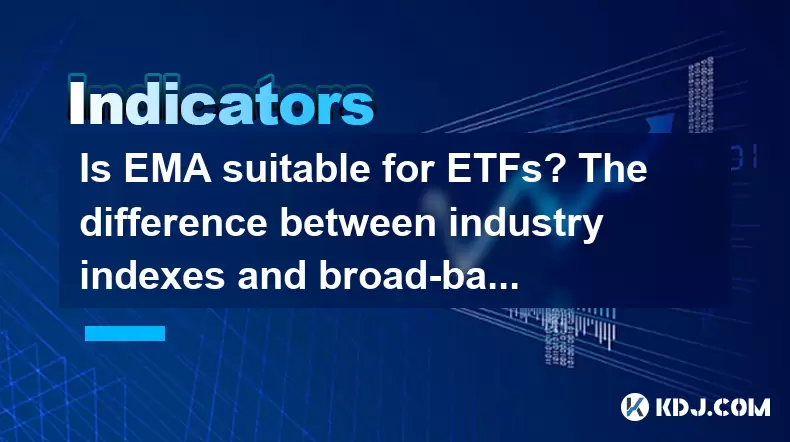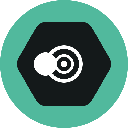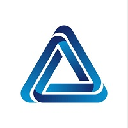-
 bitcoin
bitcoin $112195.049338 USD
2.42% -
 ethereum
ethereum $4124.915858 USD
2.81% -
 tether
tether $1.000570 USD
0.02% -
 xrp
xrp $2.861568 USD
2.25% -
 bnb
bnb $1000.346670 USD
3.04% -
 solana
solana $209.070819 USD
3.38% -
 usd-coin
usd-coin $0.999870 USD
0.02% -
 dogecoin
dogecoin $0.235379 USD
2.65% -
 tron
tron $0.335681 USD
-0.20% -
 cardano
cardano $0.803501 USD
3.38% -
 hyperliquid
hyperliquid $47.120881 USD
3.56% -
 chainlink
chainlink $21.501300 USD
3.44% -
 ethena-usde
ethena-usde $1.000571 USD
0.02% -
 avalanche
avalanche $29.793378 USD
3.62% -
 stellar
stellar $0.366964 USD
2.42%
Is EMA suitable for ETFs? The difference between industry indexes and broad-based indexes?
ETFs track assets like stocks; EMA, a responsive moving average, helps traders spot trends and entry/exit points in these funds.
May 21, 2025 at 12:21 pm

Introduction to ETFs and EMA
Exchange-Traded Funds (ETFs) are investment vehicles that track the performance of a basket of assets, such as stocks, bonds, or commodities. They are traded on stock exchanges, much like individual stocks, offering investors the flexibility to buy and sell them throughout the trading day. One of the key tools used in analyzing the performance and potential future movements of ETFs is the Exponential Moving Average (EMA). The EMA is a type of moving average that places a greater weight and significance on the most recent data points, making it a popular choice among traders and investors for its responsiveness to new information.
Understanding EMA and Its Application to ETFs
The Exponential Moving Average (EMA) is calculated by applying a specific percentage of the current price to the previous EMA value. This method results in a more reactive indicator compared to the Simple Moving Average (SMA), which gives equal weight to all data points within the period. The formula for calculating EMA is as follows:
[ \text{EMA}{\text{today}} = (\text{Price}{\text{today}} \times \text{Multiplier}) + (\text{EMA}_{\text{yesterday}} \times (1 - \text{Multiplier})) ]
Where the Multiplier is calculated as:
[ \text{Multiplier} = \frac{2}{\text{Number of periods} + 1} ]
When applying EMA to ETFs, traders often use it to identify trends and potential entry or exit points. For example, if the price of an ETF moves above its 50-day EMA, it might be interpreted as a bullish signal, suggesting that the ETF's price may continue to rise. Conversely, if the price falls below the 50-day EMA, it could be seen as a bearish signal, indicating potential further declines.
Suitability of EMA for ETFs
The suitability of EMA for ETFs largely depends on the trading strategy and time horizon of the investor. For short-term traders who seek to capitalize on quick price movements, the EMA can be highly effective due to its sensitivity to recent price changes. The EMA's ability to quickly reflect new price data makes it an excellent tool for identifying short-term trends and momentum shifts in ETFs.
For long-term investors, the EMA can still be useful, but it might be less critical compared to other indicators that focus on longer-term trends, such as the 200-day moving average. Long-term investors might use the EMA to confirm the overall direction of an ETF's price but rely more on fundamental analysis and broader market trends.
Industry Indexes vs. Broad-Based Indexes
Industry Indexes are ETFs that focus on a specific sector or industry within the economy. Examples include the Technology Select Sector SPDR Fund (XLK), which tracks the performance of the technology sector, or the Health Care Select Sector SPDR Fund (XLV), which focuses on the healthcare industry. These ETFs provide investors with targeted exposure to specific sectors, allowing them to capitalize on the growth and performance of those industries.
On the other hand, Broad-Based Indexes are ETFs that aim to replicate the performance of a wider segment of the market, often representing the overall economy or a large portion of it. Examples include the SPDR S&P 500 ETF Trust (SPY), which tracks the S&P 500 index, and the Vanguard Total Stock Market ETF (VTI), which covers the entire U.S. stock market. These ETFs offer diversified exposure to the market, reducing the risk associated with focusing on a single sector.
Key Differences Between Industry and Broad-Based Indexes
The key differences between industry indexes and broad-based indexes lie in their focus, risk, and potential returns. Industry indexes are more concentrated, offering higher potential returns if the sector performs well but also higher risk if the sector underperforms. For example, if the technology sector experiences significant growth, an ETF like XLK could outperform the broader market. However, if the sector faces challenges, such as regulatory issues or market saturation, the ETF's performance could suffer.
In contrast, broad-based indexes provide a more diversified investment approach, spreading risk across multiple sectors and industries. This diversification can lead to more stable returns over time, as gains in one sector can offset losses in another. For instance, if the technology sector struggles, a broad-based ETF like SPY might still perform well if other sectors, such as healthcare or consumer goods, are doing well.
Using EMA with Industry and Broad-Based Indexes
When using EMA with industry indexes, traders might focus on shorter-term EMAs, such as the 20-day or 50-day EMA, to capture the often more volatile movements within specific sectors. For example, a trader might use the 20-day EMA to identify short-term trends in a technology ETF, looking for opportunities to buy when the price moves above the EMA or sell when it falls below.
For broad-based indexes, traders might employ longer-term EMAs, such as the 100-day or 200-day EMA, to understand the broader market trends. A long-term investor might use the 200-day EMA to gauge the overall direction of the market, buying into a broad-based ETF like VTI when the price is above the 200-day EMA and considering selling or reducing exposure when the price falls below it.
Practical Example of Using EMA with ETFs
To illustrate the practical application of EMA with ETFs, let's consider a scenario where an investor is analyzing the SPDR S&P 500 ETF Trust (SPY). Here are the steps to apply EMA:
- Choose the EMA Period: Decide on the EMA period that aligns with your trading strategy. For short-term trading, a 20-day or 50-day EMA might be suitable, while for long-term investing, a 100-day or 200-day EMA could be more appropriate.
- Calculate the EMA: Use historical price data to calculate the EMA for the chosen period. Many trading platforms and financial websites offer tools to automatically calculate EMAs.
- Plot the EMA on a Chart: Add the calculated EMA to a price chart of the SPY ETF. This visual representation helps in identifying trends and potential trading signals.
- Analyze the EMA: Look for crossovers between the price and the EMA. A bullish signal occurs when the price moves above the EMA, suggesting potential upward momentum. A bearish signal is indicated when the price falls below the EMA, hinting at possible downward movement.
- Make Trading Decisions: Based on the EMA signals, decide whether to buy, sell, or hold the SPY ETF. For instance, if the price moves above the 50-day EMA, you might consider buying, expecting further price increases.
Frequently Asked Questions
Q: Can EMA be used effectively for both short-term and long-term trading of ETFs?A: Yes, EMA can be used effectively for both short-term and long-term trading of ETFs. For short-term trading, shorter EMAs like the 20-day or 50-day can help identify quick price movements and trends. For long-term trading, longer EMAs such as the 100-day or 200-day can provide insights into broader market trends and help confirm the overall direction of an ETF's price.
Q: How does the choice of EMA period affect trading decisions?A: The choice of EMA period significantly affects trading decisions. Shorter EMA periods, such as the 20-day or 50-day, are more sensitive to recent price changes and are useful for identifying short-term trends. Longer EMA periods, like the 100-day or 200-day, are less reactive and provide a clearer picture of long-term trends, making them more suitable for long-term investment strategies.
Q: What are the risks of focusing solely on industry indexes compared to broad-based indexes?A: Focusing solely on industry indexes carries higher risks due to their concentrated exposure to specific sectors. If the chosen sector underperforms, the ETF's value could decline significantly. In contrast, broad-based indexes offer diversification across multiple sectors, reducing the risk associated with sector-specific downturns. However, this diversification might also limit potential returns compared to a well-performing sector.
Q: How can investors balance the use of EMA with other technical indicators when trading ETFs?A: Investors can balance the use of EMA with other technical indicators by integrating multiple tools to confirm signals and reduce false positives. For example, combining EMA with the Relative Strength Index (RSI) can help identify overbought or oversold conditions, while using Moving Average Convergence Divergence (MACD) can provide additional confirmation of trend changes. By using a combination of indicators, investors can make more informed trading decisions and manage risk more effectively.
Disclaimer:info@kdj.com
The information provided is not trading advice. kdj.com does not assume any responsibility for any investments made based on the information provided in this article. Cryptocurrencies are highly volatile and it is highly recommended that you invest with caution after thorough research!
If you believe that the content used on this website infringes your copyright, please contact us immediately (info@kdj.com) and we will delete it promptly.
- SWIFT, Consensys, and Blockchain Settlement: A New Era for Global Finance?
- 2025-09-30 06:25:13
- Gold Dollar Coin, Mystery, Upright 5: Unearthing Hidden History and Whale-Sized Speculation
- 2025-09-30 06:25:13
- Meme Coins, Smart Money, 2025 Riches: Navigating the Hype
- 2025-09-30 06:30:01
- VeChain (VET) Price Prediction 2026: Bullish Breakout or Enterprise Stalemate?
- 2025-09-30 06:30:01
- BetFi Coin: Is This the Next High-ROI Crypto Presale?
- 2025-09-30 06:30:01
- Bitcoin, Nvidia, and the Potential Upside: Lessons from the AI Boom
- 2025-09-30 06:30:15
Related knowledge

What is a tower bottom candlestick pattern? Does it have a high success rate?
Sep 22,2025 at 07:18am
Tower Bottom Candlestick Pattern Explained1. The tower bottom candlestick pattern is a reversal formation that typically appears at the end of a downt...

What is a black hole pattern in the MACD indicator? Is it a cause for concern?
Sep 21,2025 at 06:54pm
Bitcoin's Role in Decentralized Finance1. Bitcoin remains the cornerstone of decentralized finance, serving as a benchmark for value and security acro...

How can I use the psychological line (PSY) to determine market sentiment?
Sep 17,2025 at 02:19pm
Understanding the Psychological Line (PSY) in Cryptocurrency TradingThe Psychological Line, commonly referred to as PSY, is a momentum oscillator used...

How can I determine if a double top pattern has officially formed?
Sep 21,2025 at 03:18am
Understanding the Structure of a Double Top Pattern1. A double top pattern consists of two distinct peaks that reach approximately the same price leve...

What is the Golden Valley pattern on the moving average? Is it better than the Silver Valley pattern?
Sep 21,2025 at 02:54pm
Understanding the Golden Valley Pattern in Moving Averages1. The Golden Valley pattern is a technical formation observed in cryptocurrency price chart...

What does a death cross of the RSI in the strong zone (above 50) mean?
Sep 17,2025 at 10:54pm
Understanding the Death Cross in RSI Context1. The term 'death cross' is traditionally associated with moving averages, where a short-term average cro...

What is a tower bottom candlestick pattern? Does it have a high success rate?
Sep 22,2025 at 07:18am
Tower Bottom Candlestick Pattern Explained1. The tower bottom candlestick pattern is a reversal formation that typically appears at the end of a downt...

What is a black hole pattern in the MACD indicator? Is it a cause for concern?
Sep 21,2025 at 06:54pm
Bitcoin's Role in Decentralized Finance1. Bitcoin remains the cornerstone of decentralized finance, serving as a benchmark for value and security acro...

How can I use the psychological line (PSY) to determine market sentiment?
Sep 17,2025 at 02:19pm
Understanding the Psychological Line (PSY) in Cryptocurrency TradingThe Psychological Line, commonly referred to as PSY, is a momentum oscillator used...

How can I determine if a double top pattern has officially formed?
Sep 21,2025 at 03:18am
Understanding the Structure of a Double Top Pattern1. A double top pattern consists of two distinct peaks that reach approximately the same price leve...

What is the Golden Valley pattern on the moving average? Is it better than the Silver Valley pattern?
Sep 21,2025 at 02:54pm
Understanding the Golden Valley Pattern in Moving Averages1. The Golden Valley pattern is a technical formation observed in cryptocurrency price chart...

What does a death cross of the RSI in the strong zone (above 50) mean?
Sep 17,2025 at 10:54pm
Understanding the Death Cross in RSI Context1. The term 'death cross' is traditionally associated with moving averages, where a short-term average cro...
See all articles


























![[Pycoin] PI Coin -Shocking Listance of Pycoin?! 'Rebellion' This time ... Pay attention to #paikoin [Pycoin] PI Coin -Shocking Listance of Pycoin?! 'Rebellion' This time ... Pay attention to #paikoin](/uploads/2025/09/29/cryptocurrencies-news/videos/pycoin-pi-coin-shocking-listance-pycoin-rebellion-time-pay-attention-paikoin/68da82f23cec1_image_500_375.webp)















































